
|
|

I
took over this e-zine when Gail, its originator was unable to continue it. With
Gail's permission, I have added her original Rock's of the Week so that everyone
can find the information readily. Please feel free to visit Gail's web site at http://www.davesrockshop.com. |
|
Agate
(Alternate May Birthstone)
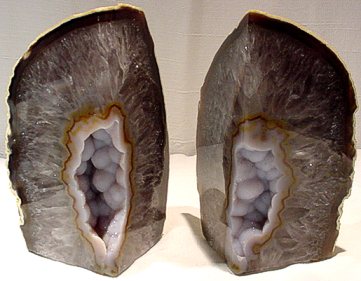
Agate bookends
|
Agate is a banded, concentric shell-like chalcedony, sometimes containing opal substance. The fine qu fibers are oriented vertically to the surface of the individual band layers. The bands can be multicolored or of the same color.
The agates of the exhausted German mines had soft to strong colors (especially pink, red, or brownish) and were separated by bright gray bands. The South American agates are mostly dull gray and without special markings; only through dyeing do they receive their lively colors. Transparency of agates varies from nearly transparent to opaque. In thin slabs, even the opaque agates are mostly translucent. |
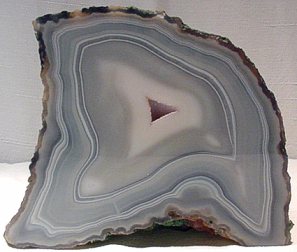
|
The name agate is supposedly derived from the river Achates (now called the
Drillo) in Sicily. Origin Agates are found as ball- or almond-shaped nodules with sizes ranging from a fraction of an inch to a circumference of several yards; more rarely they are found as fillings of crevices in volcanic rock (such as melaphyre and porphyry).
The bands are thought to be formed by rhythmic crystallization, but scientific opinions vary as to how. It was thought that the agate bands crystallize gradually in hollows formed by gas bubbles from a siliceous solution. Recently, the theory that their formation is simultaneous with that of the matrix rock has won support. According to this idea, the liquid drops of the silicic acid cool with the cooling rock and produce a layered crystallization from the outside. A new theory postulates that rather than the liquids penetrating the agate walls, colloid solutions, i.e., substances with very fine sizes of grains, flow into the agate hollows. The various agate bands vary in thickness, but normally their thicknesses remain constant throughout the nodule. Where the inner cavity of the nodule is not filled with an agate mass, well-developed crystals may have formed: rock crystal, amethyst, and smoky quartz; sometimes accompanied by
Anhydrit, Ankerit, Baryr, calcite, Goethite, hematite, siderite, and zeolite. |
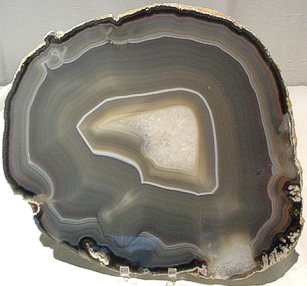
Brazilian Agate slice
|
There are many varieties of agate which go by more than one name:
Eye agate, Botswana agate, and orbicular agate - ring-shaped design with point in the center, similar to an eye.
Layer agate - Layers/bands of about the same size parallel to the
outer wall of the agate nodule.
Dendritic agate, moss agate, mocha agate - colorless or whitish, translucent chalcedony with dendrites; moss-like inclusions of hornblende or chlorite.
Enhydritic agate (also called enhydro or water stone) - Agate nodule or mono-colored chalcedony nodule, partly filled with water that can be seen through the walls. After the agate is taken from surrounding rock, the water often dries out. |

Brazilian Agate slice
|
Fortification agate, dry-head agate - agate bands with jutting-out comers like the
bastions of old fortresses.
Fire agate - opaque, limonite-bearing layered chalcedony with iridescence that is created through diffraction of the light by the layered structure.
Scenic agate - Shows landscape-like images through dendrites.
Tubular agate - Agate with numerous tubes (old feeding canals).
The mouth opening of the canals is usually bordered concentrically.
Brecciated agate - Agate, broken, but cemented together by quartz. |
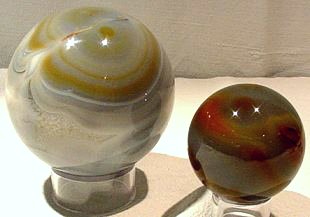
Botswana (left) and Brazilian
(right) Agate spheres
|
The most important agate deposits at the beginning of the 19th century in the neighborhood of
Idar-Oberstein/Rhineland-Palatinate, Germany. These have now been worked out. Nodules were found as large as a human head with beautiful colors of gray, pink, red, yellow, brown, and pale blue. These could not be dyed.
The most important deposits today are in the south of Brazil (Rio Grande do
Sul), and in the north of Uruguay. The deposits are layered in weathered materials and river\sediments, and are derived from melaphyric rocks. The color is generally gray; the striations are hardly recognizable. They can be given an attractive appearance by dyeing. Other deposits are in Australia (Queensland), China, India, the Caucasus, Madagascar, Mexico, Mongolia, Namibia, Wyoming, and Montana.
Agate is now used mostly for decorative items as well as jewelry.
Variety of: Chalcedony
Hardness: 6.5 - 7
Chemical Composition: SiO2 silicon dioxide |
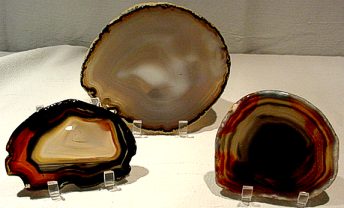
Brazilian Small Agate slices
|
History:
Agate was used for decoration in Ancient Egypt.
The Romans were possibly the first to start dying agates for decorative purposes.
Lore:
The author of "Lithica", celebrates the merits of the agate in the following lines:
Adorned with this, thou woman's heart shall gain,
And by persuasion thy desire obtain;
And if of men thou aught demand, shalt come
With all thy wish fulfilled rejoicing home.
This idea is elaborated by Marbodus, Bishop of
Rennes, in the eleventh century, who declares that agates make the wearers agreeable and persuasive and also give them the favor of God. |
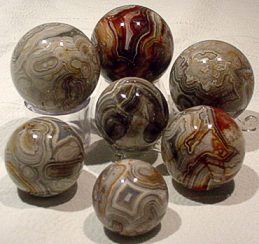
Botswana Agate spheres
|
Camillo Leonardo claims that these stones give victory and strength to their owners and avert tempests and lightning.
The agate possessed some wonderful virtues, for its wearer was guarded from all dangers, was enabled to vanquish all terrestrial obstacles and was endowed with a bold heart. The wearing of agate ornaments was even believed to be a cure for insomnia and was thought to insure pleasant dreams.
About the middle of the past century, the demand for agate amulets was so great in the Soudan that the extensive agate-cutting establishments at Idar and Oberstein in Germany were almost exclusively busied with filling orders for this trade. Brown or black agates having a white ring in the center were chiefly used for the fabrication of these amulets, the white ring being regarded as a symbol of the eye. Hence the amulets were supposed to neutralize the power of the Evil Eye, or else to be emblematic of the watchfulness of a guardian spirit. |
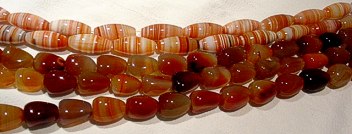
|
Metaphysical:
Agate can be used to stimulate analytical capabilities and precision. It provides for perceptiveness to situations and awakens ones inherent talents and adroitness. It has been used to facilitate channeling. It has been reported to strengthen the sight, to diminish thirst, and to promote marital fidelity.
Blue lace agate can help one to reach extremely high spiritual spaces. It contains the qualities of flight, air, movement, and grace. It is a highly inspirational influence when used for inner attunement. |
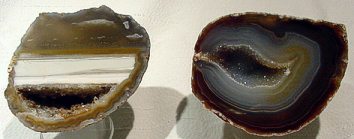
|
Botswana agate can be used to stimulate the exploration of the unknown and to further ones quest toward the enlightened state. It enhances creativity and helps one to release the emotional nuances that have been repressed. It also allows one to look toward the solution, rather than dwell on the problem. It also encourages conscientiousness and vigilance in tasks and helps one to maintain an ever-present watchfulness during the activities requiring circumspection, deliberation, and/or vigilance.
Many Brazilian agates have been dyed, but many are natural in color.
This mineral can be used to activate success in dowsing and in divining. Fastened with twine or leather upon the end of a willow, it has led the user to lost items. Brazilian agate can be used to facilitate immense strength, to assist one in diversification in fields of endeavor, and to promote meditative states and astral projection. |
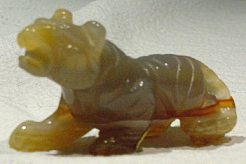
Agate tiger
|
Dendritic agate enhances gentleness and encourages one to walk lightly through the gardens of life, taking time to enjoy each moment. It helps one to remain as a directed energy during situations of discordant and/or disorienting confusion. It further assists one in maintaining the centering of the self in all situations. It is used to assist one in connecting to the natural states of the universe and to enhance communication between ones intellectual world and the plant kingdom. It is a "stone of plentitude", providing abundance and fullness in ones life. It was used in ancient Greece to produce plentiful crops, and is conducive to generous yields in both business and agricultural pursuits.
Fortification agate is conducive to deep meditative states. It furthers the understanding of the idea of universal "brotherhood", and helps one to maintain peace within the inner being. It affords one patience and encourages the acceptance of responsibility. This is a highly protective stone, helping to fortify us against unseen dangers. |
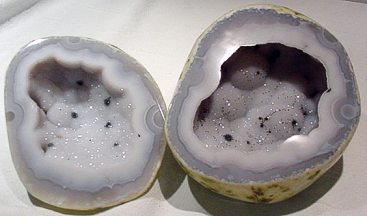
|
Fire agate represents the spiritual flame of absolute perfection. It is said to dispel fear from the very depths of the inner being and to provide a protective shield that reflects all threat of harm back to the source. It is also a stone to encourage one to be the "best" possible. Its energy provides an impetus to actions and stimulates both progression and advancement.
Mexican Crazy Lace Agate can be used to help one to reach extremely high physical levels. It helps to balance physical energies. It can bring humor and laughter to one's life, and helps to see life clearly. |
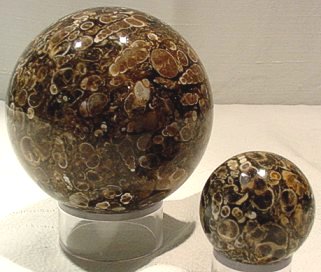
Turritella agate
spheres
|
|
Turritella agate can be recognized by the sea creature and fossil snail patterns within the stone. It is a protective stone that also allows one to recognize that the idea of safety is actually the relinquishment of the idea of attack. It also provides for a
| |



